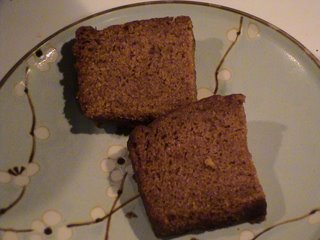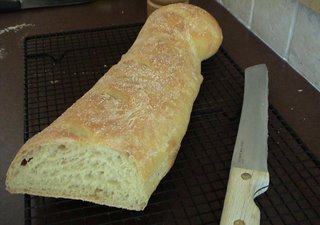 The holidays are really all about gluttony for some of us, but I actually prefer the cooking part to the eating part, strange as that may seem. Not that my food isn't good - I'll admit it's terribly good sometimes - but eating is a short-lived experience, and cooking is a slow process that adds layers of flavor one on top of another, each adding another smell to the kitchen. And the really nice thing about the holidays is that, since everyone enjoys eating so much, I get to cook more.
The holidays are really all about gluttony for some of us, but I actually prefer the cooking part to the eating part, strange as that may seem. Not that my food isn't good - I'll admit it's terribly good sometimes - but eating is a short-lived experience, and cooking is a slow process that adds layers of flavor one on top of another, each adding another smell to the kitchen. And the really nice thing about the holidays is that, since everyone enjoys eating so much, I get to cook more.I think I only really make chocolate tortes and cheesecakes and dense desserts around this time of year, as my family of four would barely make a dent in them. They're great for a crowd, and this chocolate torte recipe is especially great for a crowd that likes a really deep chocolate flavor. It starts with a ganache, which is highly versatile, and builds from there. But before I get to the torte recipe, I need to discuss a few things.
First, dark chocolate (the kind to use in baking) comes in all different flavors and levels of quality, and what chocolate you use in something with mostly just chocolate in it will make your dessert what it is, or what it should have been. This is not a time to sacrifice quality, it's a time to sacrifice whatever nice meal you were planning on later in the week to purchase the best you can get. My favorite chocolate to bake with is no longer something readily available: the Ghirardelli 10-lb. blocks of dark chocolate that I used to find broken into large chunks in the bulk section of my grocery store no longer exist. They actually aren't even made on a regular basis. I know, because I called Ghirardelli and talked to 20 people trying to find some. If you can get their Queen Anne dark chocolate melting wafers, you are a lucky person, but it's not likely. Sometimes you can still find chunks of their dark chocolate blocks, as I did recently at World Market, around the holidays. Beyond that, I don't have great recommendations. Ghirardelli's bittersweet chocolate chips will probably work pretty well, also. You can find those at most grocery stores, or a huge 3-lb. bag at World Market as well. (Very handy for keeping around the house.) Oh, and I really like the Lindt 70% cocoa bars, available only in 4 oz. bars. I've toured a lot of brands of chocolate, and I have to say it's all about personal taste. Ghirardelli and Lindt have a very smooth flavor that I like. I think Callebaut also has that same quality. Valrhona has a very sharp chocolate flavor, perhaps with a deeper roast to it. Nestle has a new 62% cocoa Chocolatier baking bar out, sold in 8 oz. bars, that I didn't like, as it didn't melt well and the chocolate wasn't outstanding, but it would do in a pinch, unless it's for drinking.
So, to begin, you need to know how to make chocolate ganache. A basic ganache is very simple: take 8 oz. of a chocolate that you like and chop it up. If it's a large chunk, chop it up with a serrated knife, as that works best. Then, separately, bring 8 oz. (1 cup) of heavy cream just barely to a simmer and pour it over the chocolate. Stir the two together until the chocolate is melted and consistently smooth. At this point, you better taste a spoonful, just to know how good it is.
A ganache like this can be used as a sauce for decadent desserts or a base for hot chocolate. My favorite drinking chocolate recipe is as follows: 1 c. milk, 1/3 c. firm ganache (3 parts chocolate to 2 parts cream), and 1 1/2 T. cocoa. Heat the milk until quite hot, whisk in the cocoa until melted, then stir in the ganache until consisted. The ganache can also be used for desserts, one of which is a Chocolate Hazelnut Torte. We should get to that point now.
But, before we do, I have one more point to make. I am a happy baker because I have the perfect cake pans. Some like their regular cake pans, some like their springform pans, but I have the best pans of all. They're my 9"x3" cake pans with removable bottoms. They're more expensive than regular cake pans, but if you get them, you will be as happy as I am every time I use them...I get giddy just thinking about it. If you don't have them, you have no idea how extraordinarily useful they are. I always line the bottom and sides of my pans with parchment paper (yes, I do measure and cut that out), and then when my cake is slightly cooled, I set the whole pan on a drinking glass and it slides right out of the pan, along with the bottom. Then I can easily remove the bottom from the cake by turning it upside down or sliding a knife or spatula along the bottom if necessary (to slide it onto a serving tray). It can be cooled on the removable bottom, even served on it. It can also be cooled completely on it, then reinserted into the main pan and thrown safely into the freezer. I also have the 6"x3" pans, which is the perfect size for half a recipe. They come in 2" tall versions as well, but don't go there. If you make a cheesecake or torte, you'll be a wee bit shy of enough room for a large recipe.
Okay, on to the chocolate torte:
12 oz. heavy cream
5 T. sugar
1 t. vanilla
5 eggs, separated
1 c. whole hazelnuts
First, roast the hazelnuts in a 350° oven for 12-15 minutes, until fragrant and the skins are peeling back. Remove them and cool slightly. Reduce the oven temperature to 325°.To remove the skins, take a handful and rub it back and forth between your two hands until the nuts are mostly cleaned. Place them in a food processor with 2 T. of sugar and process until finely ground. If you do this too long when they're warm, you'll end up with hazelnut butter, so be careful of that.
Reduce the oven temperature to 325°. Prepare your 9"x3" or 10"x2" cake pan or springform pan by spraying the pan with cooking spray, then lining the bottom and sides with parchment paper. (No need to spray the paper.)
Make the ganache: chop the chocolate up, heat the cream, pour the cream over the chocolate, and stir until smooth. Let this cool a bit before continuing.
Mix the vanilla, and egg yolks into the ganache. Separately, whisk the egg whites with the remaining 3 T. sugar to medium peaks, then fold the whites into the ganache in 3 batches. Being careful not to stir too long. Stir in 2/3 cup of ground hazelnuts.
Pour the batter into your prepared pan and bake for 50 minutes, until the cake is well-set. Remove to a cooling rack and cool 5 minutes, then remove the sides of the pan if you're using a springform or removable bottom pan. Cool completely, then chill. This torte is great prepared 1-2 days in advance at least, as the flavors will have more time tow meld. Serve with whipped cream or raspberry sauce.

At this point, I've mixed in part of the egg whites and I'm adding more to them.

This is what the torte looks like upon removing it from the oven: a little crackly but no longer jiggly.

After several minutes, you'll see a large crack in the middle. Don't be shocked. The cake is very much like a souffle, so this is to be expected and won't detract from the texture at all.
I made two chocolate tortes, along with two cheesecakes, for my guests last week. I had prepared the desserts early in the week and frozen them, then set them on my chest freezer to thaw, thinking the easiest way to slice them would be when they're partially frozen. Unfortunately, I left the garage door open, and a stray dog made his way into my garage, pulled one
 of these well-wrapped tortes off the top of the freezer, dragged it into the front yard, and only stopped licking his plate when I came outside to find this. In case you can't tell from the picture, there's nothing left. The dog didn't belong to any of my neighbors and had a collar on but no tags, so I couldn't contact his owner to let them know of the impending sickness that would overcome a dog that eats 12 oz. of dark chocolate. Eventually, the poor thing wandered off, leaving me crestfallen over my dessert, and wondering what the dog's fate will be.
of these well-wrapped tortes off the top of the freezer, dragged it into the front yard, and only stopped licking his plate when I came outside to find this. In case you can't tell from the picture, there's nothing left. The dog didn't belong to any of my neighbors and had a collar on but no tags, so I couldn't contact his owner to let them know of the impending sickness that would overcome a dog that eats 12 oz. of dark chocolate. Eventually, the poor thing wandered off, leaving me crestfallen over my dessert, and wondering what the dog's fate will be.





